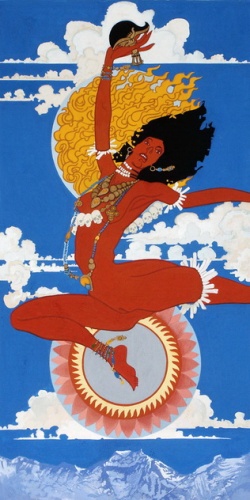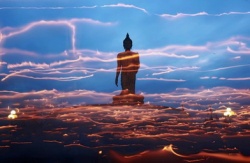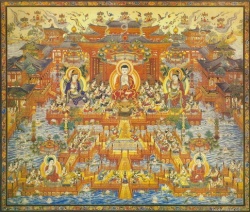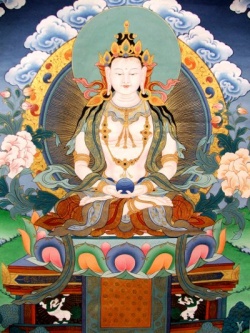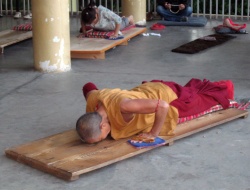The Tibetan Book of the Dead
THE TIBETAN BOOK OF THE DEAD is the most celebrated and widely read work of Tibetan literature outside Tibet.
The book was first published in English in 1927 by Walter Y. Evans-Wentz, compiled and edited from a selection of original translations of Tibetan texts by the Sikkimese teacher Kazi Dawa-Samdup.
From its first appearance in America and Europe, this book has enjoyed a long and remarkable career in Western popular culture, due in large part to its perceived religious and psychological insights and practical benefits.
The translated text has appealed to generations of spiritually inquisitive Westerners, comparative philosophers, psychoanalysts, neuroscientists, medical anthropologists, hospice caretakers, and psychedelic truth-seekers.
Since 1927, eight additional translations from the same group of Tibetan texts have appeared, including original studies in
Italian (Giuseppe Tucci, 1949),
German (Eva Dargyay, 1977),
Hungarian (György Kara, 1986),
Spanish (Ramon Prats, 1996), and a few more translations in
English (Francesca Fremantle and
Chögyam Trungpa, 1975;
Robert Thurman, 1994;
Stephen Hodge and
Martin Boord, 1999).
The Tibetan Book of the Dead has appeared also in various nonliterary forms, as a video documentary, a theatrical drama, and a musical opera.
The list of incarnations continues, and the book’s appeal seems everlasting.
It has now reappeared in its finest and most complete form in this excellent new English translation by Gyurme Dorje, edited by Graham Coleman and Thupten Jinpa, and introduced by His Holiness the Dalai Lama.
As it is known in the West, The Tibetan Book of the Dead —a title created by Evans-Wentz with no Tibetan equivalent—is a collection of smaller texts or “chapters” on Tibetan Buddhist perspectives on death and the dying experience, the hallucinatory transitional states (bardo) between lives, and the process of rebirth.
In Tibetan the collection is titled The Great Liberation by Hearing in the Intermediate States and belongs to a much more extensive body of literature known as The Peaceful and Wrathful Deities: Natural Liberation through Enlightened Intention.
Evans-Wentz’s selection of the small group of chapters from the The Great Liberation by Hearing as a unified “book” with a coherent narrative and a simple title became the standard for all future presentations of the Tibetan work, influencing as well the many varied interpretations of its content.
But this selective arrangement has been somewhat misleading and has obscured the fact that in Tibet there existed, and still exists, a wide diversity of arrangements of this collection, its content quite vast.
When taken as a whole within the framework of the larger cycle of The Peaceful and Wrathful Deities,
this so-called Tibetan Book of the Dead and related works actually comprise as much as
several hundred texts on ritual,
philosophical doctrine,
advanced techniques of yoga and meditation,
dream prognostication,
demon exorcism,
funeral liturgy,
tricks for cheating death,
confessional and devotional prayers, and so on.
The titles of the great majority of these works are listed in Appendix One of Gyurme Dorje’s new edition.
It should also be noted with some enthusiasm that the newest translation here includes nine major works from this Tibetan literary cycle that until now have not been included as part of the standard version of The Tibetan Book of the Dead first set by Evans-Wentz in 1927.
With the addition of these nine “chapters,” Gyurme Dorje and his team have presented for the first time in any Western language The Great Liberation by Hearing in its complete and most authoritative form.
The fourteen chapters of the book have been arranged “according to the meaningful sequence of the intermediate states that arise in the course of life and death” and not according to the traditional scheme found in the Tibetan collection.
This choice of sequence may not be historically precise, but it does succeed in sustaining a unified and conceptually logical narrative, which is what most readers familiar with the earlier versions of the Book of the Dead have come to expect.
IN ADDITION TO BEING the first complete translation in English of The Great Liberation by Hearing,
this new edition is also the first version of The Tibetan Book of the Dead to place the work in its proper traditional contexts by elucidating its specific practical, theoretical, and iconographic foundations—namely, the Great Perfection (Dzogchen) systems of the Nyingma school—and by highlighting its literary history.
Moreover, each of the twelve chapters are introduced by brief contextualizing comments, usually about the ritual uses of the text, written by the Bhutanese scholar Dasho Sangay Dorji.
Despite the common view in previous translations and commentaries that the Book of the Dead is an ancient text from Tibet’s distant past, a timeless treasure of wisdom (for example, even on the cover of the new book we read “hidden away for many centuries, this ancient treasure text . . . ”), in actual point of fact this Tibetan “book” is really not that old, and it does have a clear history.
The translator and editors deserve to be applauded for their acknowledgment that this extraordinary work of Tibetan religious culture is most meaningful when explained in its own terms and best understood in its own context.
Tibetan tradition attributes authorship of The Great Liberation by Hearing and The Peaceful and Wrathful Deities to Padmasambhava, the eighth-century esoteric master from OrgyEn (Swat Valley in modern-day Pakistan) who is universally recognized by Tibetans as the figure principally responsible for establishing Buddhism in Tibet.
Padmasambhava is believed to have concealed these teachings as a religious “treasure” (terma) to be revealed at a later date.
In the fourteenth century these hidden teachings were said to have been recovered by Karma Lingpa, an obscure “treasure-revealer” (terton) who hailed from the Dakpo region of southeastern Tibet.
Karma Lingpa’s Great Liberation by Hearing tradition was initially fostered in Dakpo and attracted followers from a diversity of Tibetan Buddhist lineages, most prominently those of Nyingma and Kagy affiliation.
The doctrines and rituals belonging to the treasures of Karma Lingpa were refined and redacted in the late fifteenth century by Gyarawa Namka Chokyi Gyatso (b. 1430), abbot of Menmo monastery in nearby Kongpo.
The texts of The Peaceful and Wrathful Deities, including those comprising The Great Liberation by Hearing, were eventually transmitted by Gyarawa and his many students to other parts of Tibet, as well as to Bhutan and Sikkim.
Throughout the sixteenth and seventeenth centuries the tradition of The Great Liberation by Hearing was most actively maintained in southern and south-central Tibet.
The tradition also flourished in Kham, eastern Tibet, through the efforts of Rikzin Nyima Drakpa (1647-1710), another famous treasure-revealer.
It was Rikzin Nyima Drakpa who first standardized the texts and arrangement of The Great Liberation by Hearing, and his work was eventually printed for the first time in the eighteenth century by the Third Dzogchenpa Ngedon Tendzin Zangpo (1759-1792), incarnate lama of Dzogchen monastery in Kham.
The printed edition of Rikzin Nyima Drakpa’s arrangement of The Great Liberation by Hearing became the principal format for subsequent Tibetan-language editions and served as the basis for the first Western-language translation published as The Tibetan Book of the Dead by Evans-Wentz in 1927.
All but one text (the short lineage prayer) from Rikzin Nyima Drakpa’s collection are included in the new Viking translation, with the addition of two introductory works from the larger Peaceful and Wrathful Deities cycle.
The appearance of this new complete Tibetan Book of the Dead by Gyurme Dorje, Graham Coleman, and Thupten Jinpa is a major landmark in the enduring tradition of the classic Tibetan Buddhist work.
The translations and commentary are superb, and this edition will no doubt quickly establish itself as the new definitive Western standard.
Bryan J. Cuevas is Associate Professor of Buddhist and Tibetan Studies at Florida State University.
He is the author of The Hidden History of the Tibetan Book of the Dead.
Source
http://www.tricycle.com/reviews/real-dead-definitive-translation
